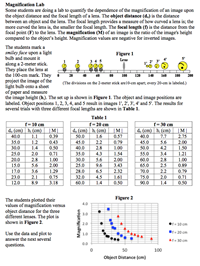 Lens Magnification Lab
Lens Magnification Lab
Resource:
The Science Reasoning Center: Lens Magnification Lab
Grade Level: High School
Description:
This passage describes a student experiment investigating the effect of the object distance from a lens upon the characteristics of the image that is formed by the lens. Data is presented in the form of a diagram, three tables and a graph. Questions target a student's ability to determine the effect of one variable upon another variable, to select information from a table or graph, to interpret a complex diagram, to draw conclusions that are consistent with two or more data presentations, to interpolate and extrapolate from a table or a graph, and to make predictions based upon a model.
This activity aligns with the three dimensions of the Next Generation Science Standards in the manner described below:
| Patterns: Empirical evidence is needed to identify patterns. |
Patterns can be observed by visualizing data in many ways. In this passage, students use a visual image, data tables, and a graph as they look for patterns within their collected data. As they do, students are able to clearly see an inverse relationship between object distance and magnification as well as a direct relationship between focal length and magnification. Students are then asked to use these patterns to make predictions as they interpolate between and extrapolate beyond the data presented. |
| Scale, Proportion, Quantity: Algebraic thinking is used to examine scientific data and predict the effect of a change in one variable on another (e.g., linear growth vs. exponential growth). |
As students consider tabular, pictorial, and graphical representations of student-collected data in this passage, they must use algebraic thinking to predict the effect that changing one variable has on another. While one inverse and one direct relationship emerge, students encounter a situation where the value of one quantity approaches a non-zero value as the magnitude of another quantity gets very large. The meaning of this asymptotic value is explored in some of the passage-end questions as students are asked to extrapolate beyond the range of collected data. |
| Developing and Using Models: Develop or use a model based on evidence to illustrate the relationships between systems or between components of a system. |
Models can be pictures, graphs, equations, analogies, or physical constructions that are used to represent a relationship or idea. In this passage, students are asked to use models that illustrate the relationship that exists between object distance and magnification as well as between focal length and magnification. The passage shows student-collected data displayed in three different forms (diagram, table, graph) to help students discover these relationships. Students then use these models to summarize general relationships and to make predictions for new situations. |
| Analyzing and Interpreting Data: Analyze data using tools, technologies, and/or models (e.g., computational, mathematical) in order to make valid and reliable scientific claims or determine an optimal design solution. |
Data within this passage is presented in the form of a diagram, three tables and a graph. Questions target a student's ability to determine the effect of one variable upon another variable, to select information from a table or graph, to interpret a complex diagram, to draw conclusions that are consistent with two or more data presentations, to interpolate and extrapolate from a table or a graph, and to make predictions based upon a model. |
| Engaging in Argument from Evidence: Make and defend a claim based on evidence about the natural world that reflects scientific knowledge, and student-generated evidence. |
This passage describes a lab experiment in which students collected data to quantify the dependence of the magnification of an image upon the object distance and the focal length of a lens. Several passage-end questions ask students to make and defend claims based on this collected data. As an example, one question asks students to make and defend a claim regarding the magnification of the image when the object distance is equal to three focal lengths. As students consider the large amount of data collected, they are able to find two pair of data that will allow them to make an argument regarding this relationship and use evidence to support their claim. |
Associated Reading from The Physics Classroom
Other Supporting Pages at The Physics Classroom:
View Infographic.
(Coming Soon)
Search the NGSS Corner
Maybe you're looking for something really specific that pertains to a desired topic and emphasizes one or more of the listed NGSS dimensions. Why not try a search of this section of our website? Simply select from one or more of the pull-down menus and click Search This page will reload and a collection of possibilities will be displayed in this section of the page and sorted by relevancy.